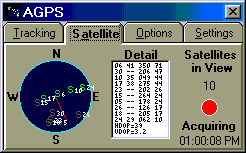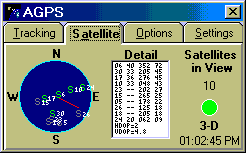You can find out the answer from National Air and Space Museum
A computer compatible GPS receiver can output data from a serial port (COM port). The GPS software will read the positioning data from the in-coming serial port. Now a day, there are several compact flash card (CF card) or flash card (PC card) GPS receivers in the market. In fact, these kind of PC card GPS is a combo of a serial port and a GPS receiver. Once you plug in the PC card receiver, you will see an additional com port is available to your computer. You can configure your GPS software toward the correct com port in order to read the data. I recommend the PC card or CF card based GPS since it can be used on your laptop as well as your PDA. For the external GPS receivers, your computer must equip with an available serial port in order to connect to the external receiver. Note that from several users' report, some of the USB based GPS are not quite work with AGPS since their serial port simulator is not stable and may crash your system some time.
Important! Please read the
following paragraph before you buy a GPS receiver:
On the other hand, there are two type of GPS data protocols: NMEA 183
version 2.x and the Rockwell Zodiac GPS protocol. If you have a
Zodiac protocol only GPS (Zodiac 1.x), you are out of luck because it is a proprietary protocol and
most of the software does not support it. FYI,
DeLorme EarthMat comes with a Zodiac GPS
receiver. If you purchase it, you are stuck with Delorme. AGPS
2.1 and up supports the Zodiac GPS chipset that has NMEA183 extension. (e.g.
TripMat) Even if you found a NMEA 183 compatible GPS (most of the GPS receivers in
the market have NMEA 183 data output), make sure to read the detail NMEA 183
sentences that it supports. The minimum sentences we recommended
to have are both RMC and GGA in order for a GPS software to display the
time, traveling speed, heading, position and elevation.
Some GPS receivers only output GGA sentence, that is not enough.
Please read and print the complete list of NMEA 183 protocols at the end of this
FAQ page before you make decision.
Known GPS not supported by AGPS
- Navman eSeries USB based GPS (problem in the driver.) New(3/24/03): Click here for the latest beta driver from Navman that work with AGPS
- DeLorme Earthmat GPS (Zodiac 1.x chipset)
The Crux-II PC card GPS is very cool (see
my GPS gear). When you purchase it, make sure to purchase the
external antenna (it is an active antenna) because the built-in antenna is not quite sensitive for the
in-car environment (or partially blocked sky). Also because the
built-in is not sensitive, it requires at least 2 minutes to find the
satellites during the GPS initialization. With the external antenna,
it will only take less than 30 seconds.
In the US, you can purchase it from http://www.mobileplanet.com
(Teletype brand)
In the Europe, here is a list of location:
http://www.premierelect.co.uk
http://www.navicar.nl
www.papyrus.co.il
http://www.p-map.it
http://fritz.ganter.at
FYI, I brought mine from Premierelect.co.uk since it is cheaper comparing to
the MobilePlanet.
For the new driver download, please visit EMTAC
Corporation.
The other trend now is to buy a compact flash version of GPS receiver since it can plug into the iPAQ or other palm top (and is cheaper too, $200). In order to make it a PC card GPS, you just buy a Compact Flash PC card adaptor and make sure the manufactory has a Windows driver for downloading. The adaptor is cost $15 in the MobilePlanet (Kingston brand). We currently have not test this combination, so please make sure you are able to return to the shop if this does not work.
As long as your GPS receiver supports GGA or RMC (that most of the GPS receivers do), the basic location information will be displayed. The more your GPS receiver supports, the more AGPS features will be activated. Please check with the complete list of NMEA requirements for each individual features.
No GPS means either there is no signal received
from the satellite or your receiver is not functional properly.
Acquiring means there is signal received for the satellite(s) but the
data may not be accurate, usually happen when only 1 satellites signal
is received by the receiver.
2-D means only the latitude and longitude information is
accurate, usually happen when the receiver receives signals from less
than 3 satellites.
3-D means all three dimension data is accurate, usually happen when
the receiver receives signals from more than 3 satellites.
Sometimes the GPS receiver isn't able to figure out the current location either because of the GPS signal is too weak/not picked up by the receiver (satellites gray out from the AGPS satellite monitor) or the information is not good to derive the current location. The following is the screen shot demonstrates when all the active satellites were "lined up" in the sky, that causes the receiver is not able to derive the current location.
|
|
|
The AGPS will take the data from one or more protocols by the following listed priority. (e.g. if 1 is not presented, use 2). Check your GPS receiver manual to confirm the AGPS functionalities that will be activated by your GPS receiver.
For the basic Latitude/Longitude extraction
- GGA
- RMC
- GGA
- RMC
- GGA
- RMC
- RMC
- RMC
- GSA
- GGA
- RMC
- GSV
- GGA
- GSV
- GSA
- GSA
- GGA
- GSA
 4
1. Four Active satellites "lined up" in the sky. Causing
the GPS receiver warning.
4
1. Four Active satellites "lined up" in the sky. Causing
the GPS receiver warning.